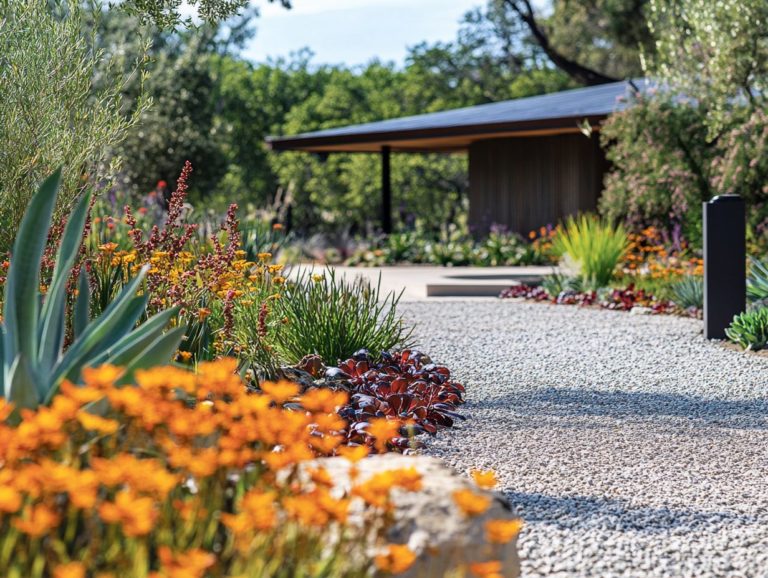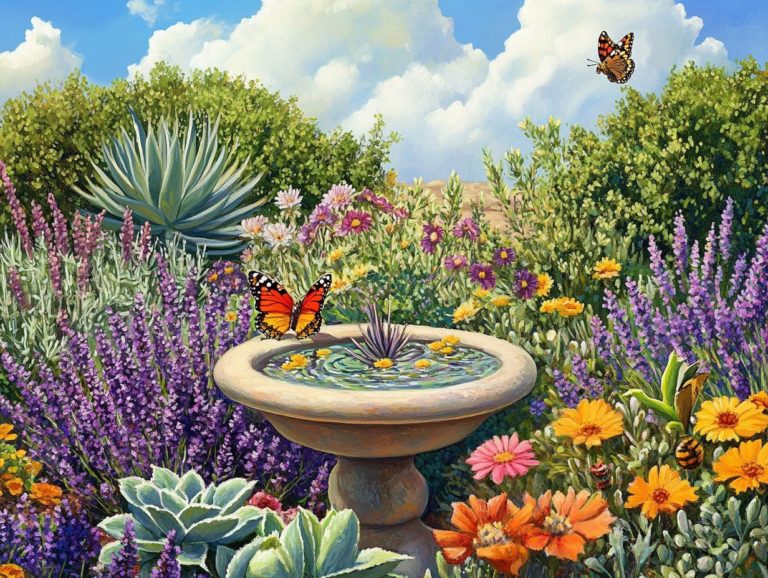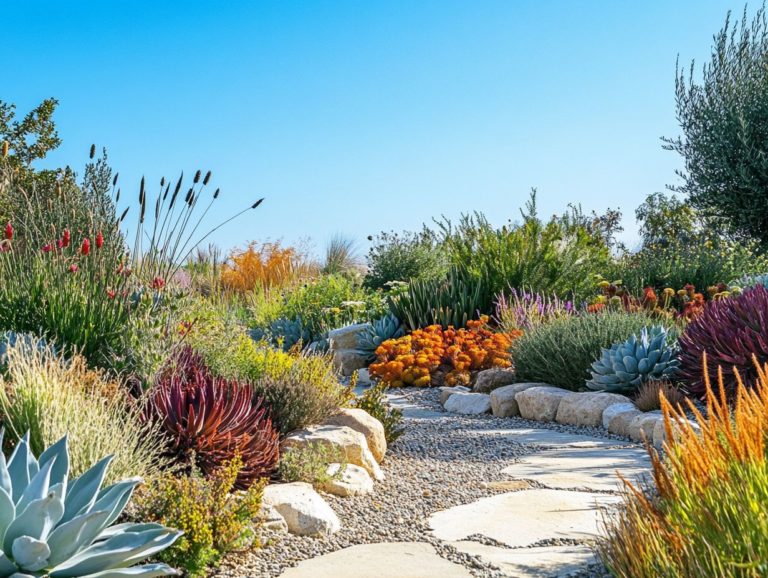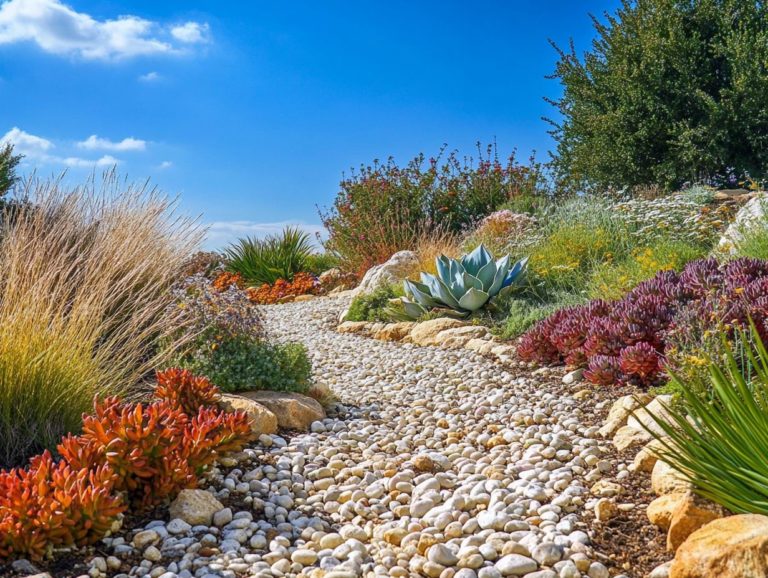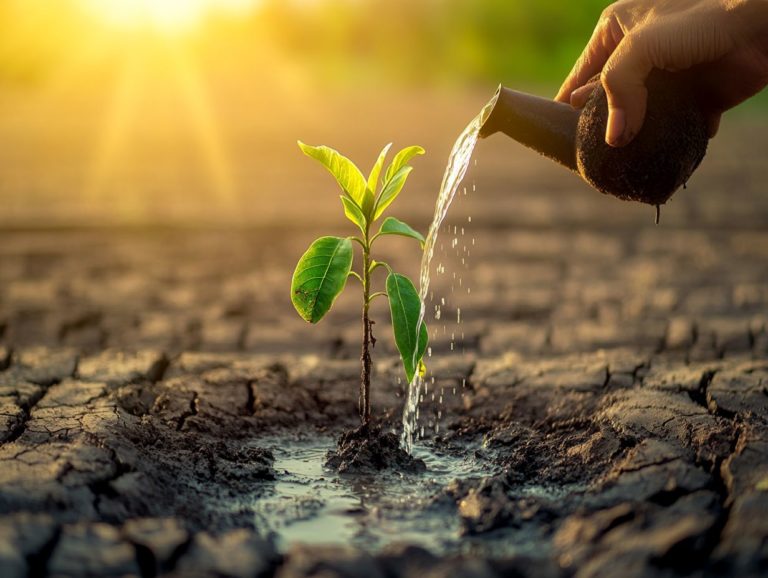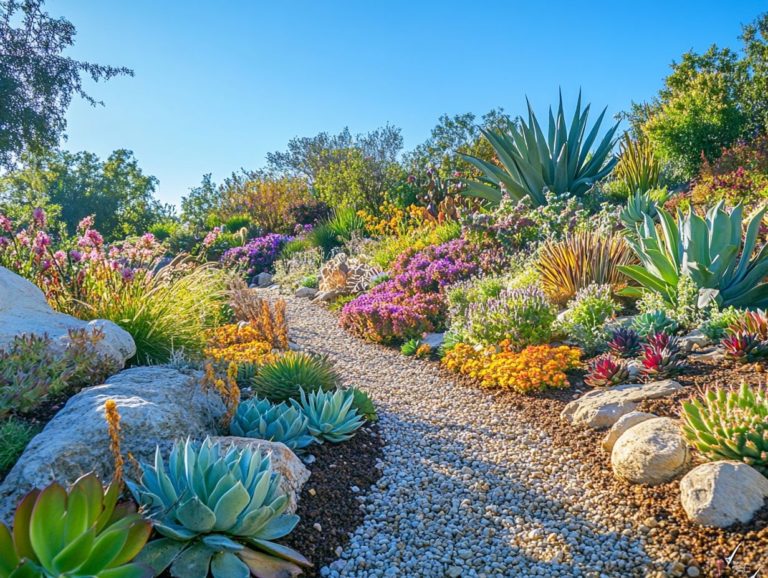Integrating Hardscaping in Drought Areas
Drought is emerging as a significant concern, influencing landscapes and ecosystems across the globe. As water shortages become more pronounced, it’s vital for you to understand how to adapt your outdoor spaces effectively.
This article explores the effects of drought on landscapes and presents hardscaping as a sustainable solution. You’ll discover strategic design choices, suitable materials, and maintenance tips that can elevate your outdoor environment.
It also emphasizes the art of harmoniously integrating hardscaping with drought-tolerant plants, creating a resilient and visually appealing landscape.
Contents
- Key Takeaways:
- Understanding Drought and Its Impact on Landscapes
- Benefits of Hardscaping in Drought Areas
- Incorporating Hardscaping into Landscape Design
- Choosing the Right Hardscape Features
- Maintaining Hardscaping in Drought Areas
- Combining Hardscaping and Drought-Tolerant Plants
- Frequently Asked Questions
- What is hardscaping and how does it relate to drought areas?
- What are the benefits of integrating hardscaping in drought areas?
- How can I incorporate hardscaping in my drought-resistant landscape?
- Are there any specific hardscaping materials that are recommended for drought areas?
- Is hardscaping suitable for all types of drought areas?
- How can I maintain my hardscaping in a drought area?
Key Takeaways:
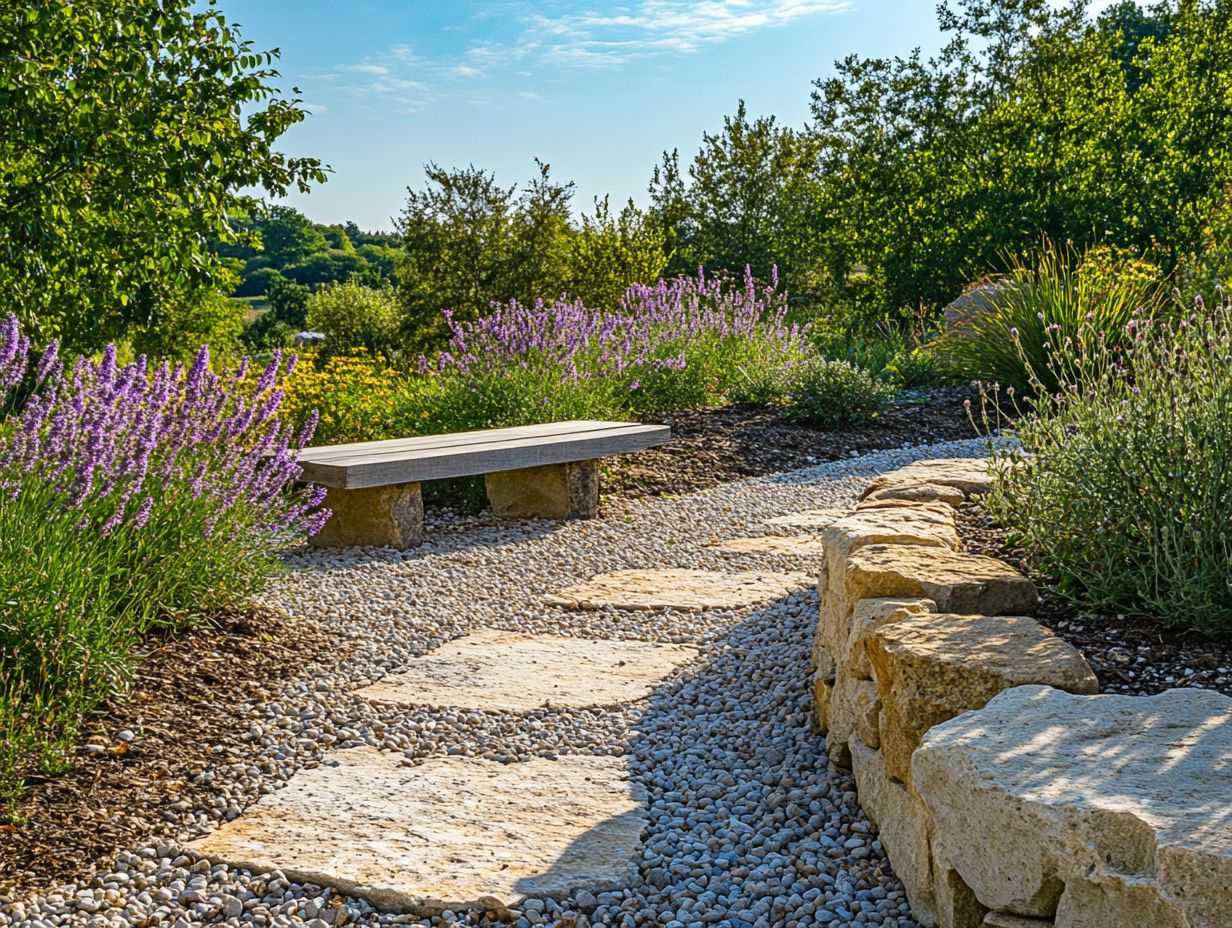
- Hardscaping in drought areas helps conserve water and minimizes maintenance, making it a practical and sustainable choice for landscape design.
- Adding hardscaping elements and picking the right materials enhances both the functionality and aesthetics of a landscape while withstanding drought conditions.
- Combining hardscaping with drought-tolerant plants creates a balanced, sustainable landscape that reduces the need for excessive watering and maintenance.
Understanding Drought and Its Impact on Landscapes
Drought, marked by extended periods of inadequate rainfall, profoundly affects landscapes, especially in areas like California, where water conservation is crucial. As a result, the landscaping industry faces significant challenges in maintaining plant health and soil moisture.
This reality calls for innovative solutions, such as drought-resistant landscaping and advanced irrigation systems, to address the impacts of water scarcity effectively. Understanding this will empower you to grasp the relationship between climate adaptation strategies and the selection of native plants.
This knowledge empowers you to create resilient landscapes that thrive even in tough conditions.
What is Drought and How Does it Affect Landscapes?
Drought is an extended period of inadequate precipitation compared to the statistical multi-year average for your region, resulting in water scarcity that significantly impacts both plant life and soil health.
As this phenomenon unfolds, you’ll notice critical repercussions across various landscapes, including a decline in plant vitality as they struggle to access the moisture they need. The depletion of soil moisture doesn’t just hinder the growth of typical flora; it also challenges drought-tolerant species that would usually thrive in such conditions. These effects ripple through entire ecosystems and agricultural productivity, creating a broader impact that can’t be ignored.
For this reason, it s vital to explore innovative water conservation strategies. Approaches like xeriscaping a landscaping method that reduces the need for watering and rainwater harvesting can help mitigate these harsh effects, paving the way for healthier, more resilient environments.
Benefits of Hardscaping in Drought Areas
Hardscaping offers a wealth of advantages for landscapes in drought-prone regions. It not only provides effective water conservation solutions but also enhances the aesthetics of drought-resistant landscaping, reducing the maintenance demands of your outdoor spaces.
It also boosts the visual appeal of your landscape, transforming it into a visually striking environment.
Conserving Water and Minimizing Maintenance
Implementing water-saving strategies through hardscaping can dramatically reduce your overall water consumption while easing the maintenance burden typically associated with traditional landscaping. For those in dry regions, following landscape maintenance tips for drought areas can be particularly beneficial.
By integrating efficient irrigation systems like drip irrigation or smart timers you can ensure that your plants receive the right amount of water they need, significantly cutting down on waste. The use of mulch plays a dual role: it retains soil moisture and suppresses weeds, further bolstering your landscape s sustainability.
These techniques work in harmony; careful irrigation planning reduces water requirements while mulch adds a touch of humidity to the mix. Together, these methods cultivate a greener environment, making hardscaping not just a stylish choice but also a smart one for homeowners eager to conserve water.
Incorporating Hardscaping into Landscape Design
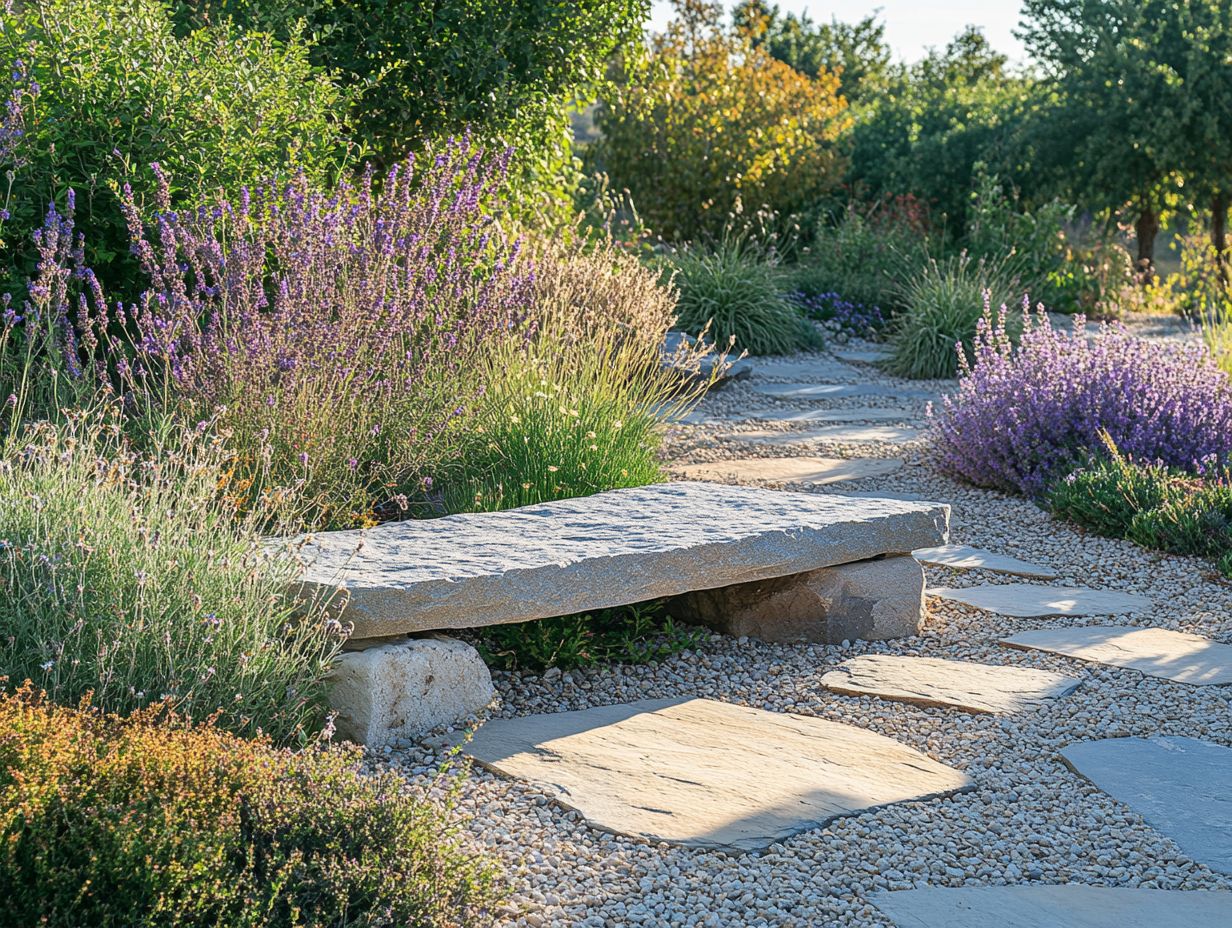
Incorporating hardscaping elements into your landscape design enhances water efficiency, particularly through water features in drought-tolerant landscapes. This approach works especially well in dry regions to ensure every drop counts.
Strategic Placement and Materials
Choosing the right hardscape materials and placing them thoughtfully within your landscape design is essential. This creates a visually stunning and water-efficient garden environment.
As you envision the overall aesthetic of your outdoor spaces, selecting materials like stone, gravel, or permeable pavers becomes paramount. These choices support sustainable practices and create a strong foundation that beautifully complements the natural allure of ornamental grasses and drought-tolerant plants.
Integrating these elements creates a harmonious look. It adds both texture and color contrasts. Imagine a patio area adorned with sleek concrete slabs that gracefully highlight the soft, swaying movement of fountain grass. Well-placed gravel paths enhance drainage and guide the eye toward vibrant succulents or xerophytes (plants that thrive in dry conditions) in nearby beds.
Successful landscape designs seamlessly blend these components, transforming your outdoor spaces into functional yet breathtaking retreats.
Choosing the Right Hardscape Features
Choosing the perfect hardscape features can transform your space! It’s crucial for achieving a harmonious balance between functionality and aesthetics, especially in sustainable landscapes designed to withstand drought conditions.
Prioritizing Functionality and Aesthetics
In landscape design, you should prioritize functionality alongside aesthetics. This ensures that hardscape features enhance visual appeal and contribute to efficient maintenance, especially when paired with drought-tolerant plants.
This balance is essential for creating stunning and practical spaces. Well-placed pathways guide visitors seamlessly through your garden, while strategically positioned seating areas invite relaxation. Incorporating decorative stones and thoughtfully selected plantings elevates the overall ambiance, making the environment more inviting.
A harmonious blend of these elements promotes sustainability, reducing water usage and minimizing maintenance needs. This intentional approach encourages biodiversity and supports local ecosystems, ultimately creating a landscape that thrives naturally while effectively serving the community.
Maintaining Hardscaping in Drought Areas
Effective maintenance of hardscaping in drought-prone areas is essential for preserving both longevity and visual appeal. By incorporating practices such as regular inspections and the strategic application of mulch, you can significantly enhance soil moisture retention.
Tips for Long-Term Maintenance and Care
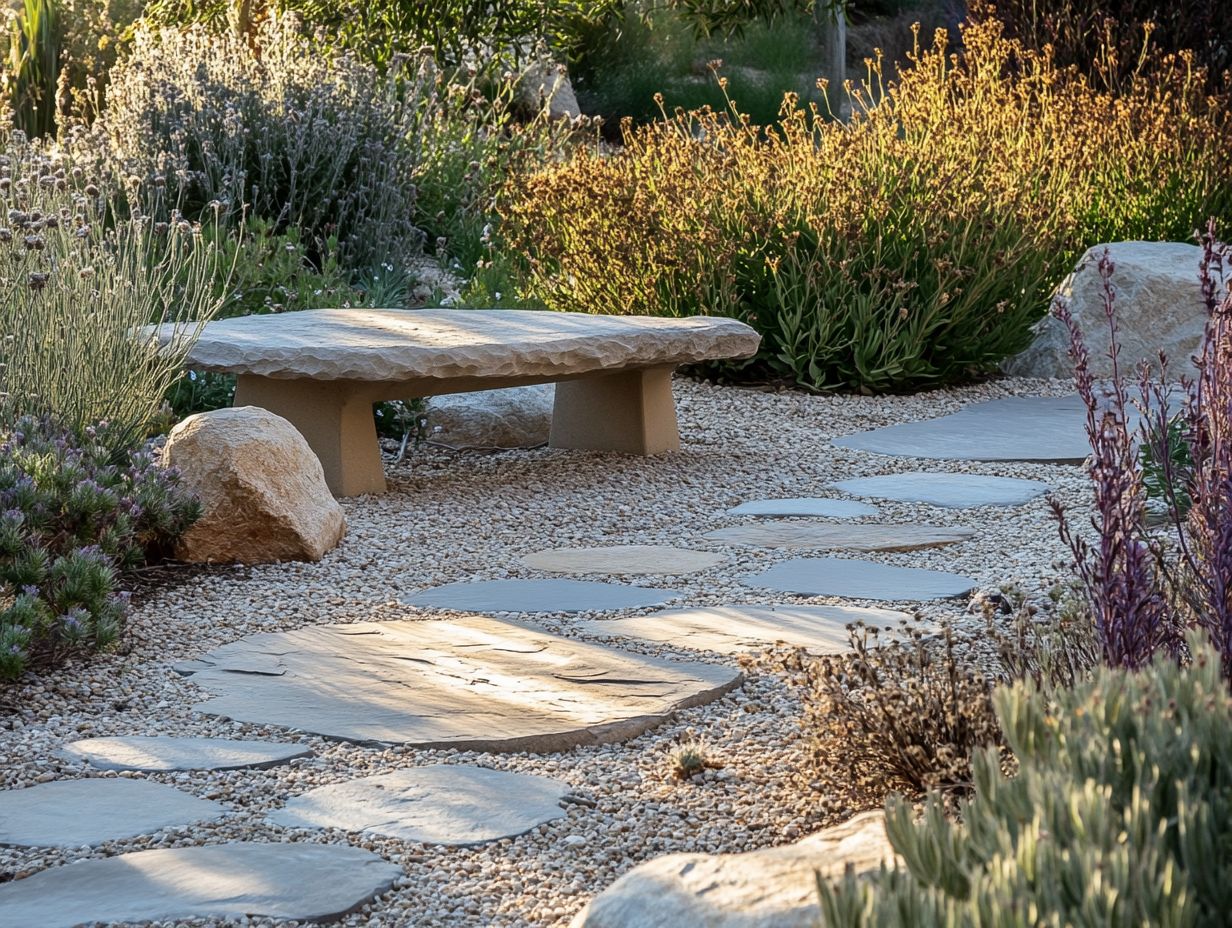
Long-term maintenance and care of hardscaping elements require a proactive approach. Emphasizing effective landscape maintenance routines includes mulch application and regular updates to irrigation systems.
To ensure your landscape thrives even under harsh conditions, integrating organic mulch can significantly enhance moisture retention and regulate soil temperature. Schedule routine checks of your irrigation system to ensure it delivers water efficiently, avoiding any wastage.
Opting for drip irrigation methods instead of traditional sprinklers can be a game-changer. It directs water precisely where it’s needed while minimizing evaporation. For those interested in enhancing their outdoor spaces, exploring the future of drought-resistant landscaping can offer valuable insights. Implementing seasonal care routines like replenishing mulch in the spring and maintaining clear drainage pathways will further solidify the resilience of your hardscaping.
Start planning your drought-resistant garden today!
Combining Hardscaping and Drought-Tolerant Plants
Combining hardscaping with drought-tolerant plants creates a beautiful and sustainable landscape. This approach conserves water and enhances biodiversity.
Creating a Balanced and Sustainable Landscape
Creating a balanced landscape requires careful selection and placement of hardscaping elements and native plants. Each component should work together to optimize water efficiency.
Consider incorporating landscaping that uses drought-resistant plants that thrive in your local conditions. Using permeable paving for paths and driveways minimizes runoff and enhances groundwater recharge. These strategies support local wildlife and reduce the need for excessive irrigation.
By thoughtfully integrating hardscaping features like natural stone walls or decorative boulders, you can craft functional outdoor spaces that celebrate the beauty of nature. This approach creates a stunning design that honors the environment.
Frequently Asked Questions
What is hardscaping and how does it relate to drought areas?
Hardscaping includes using materials like stones and bricks in landscaping. In drought areas, it provides a low-maintenance and sustainable alternative to traditional landscaping options, enhancing the aesthetics of drought-tolerant landscapes.
What are the benefits of integrating hardscaping in drought areas?
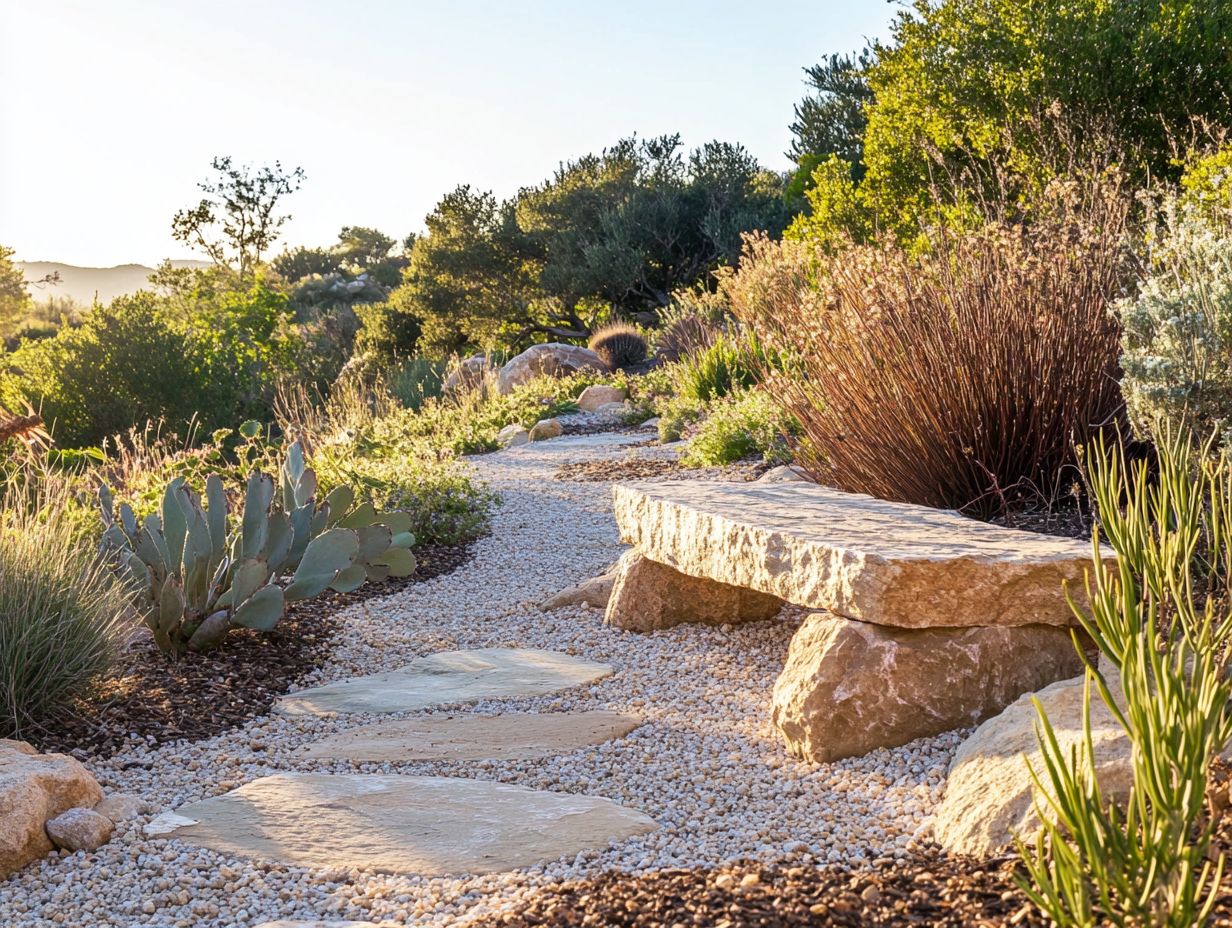
Integrating hardscaping in drought areas conserves water by reducing the need for grass and other water-intensive plants. For those dealing with limited space, exploring small space landscaping for drought areas can also add visual interest and functionality to outdoor spaces.
How can I incorporate hardscaping in my drought-resistant landscape?
You can add elements such as gravel pathways, stone patios, and retaining walls. These features complement and enhance the overall design of your drought-resistant landscape.
Are there any specific hardscaping materials that are recommended for drought areas?
Recommended materials include permeable pavers, which allow water to seep through and reduce runoff, and decomposed granite, which can serve as a low-maintenance lawn alternative.
Is hardscaping suitable for all types of drought areas?
Hardscaping is suitable for most drought areas, and using gravel in drought-friendly designs can enhance your landscape. However, it’s essential to consider the local climate and soil conditions. Consulting a professional landscaper can help determine the best options for your area.
How can I maintain my hardscaping in a drought area?
To maintain hardscaping, regularly sweep and remove debris from pathways and patios. Check and repair any cracks in pavers or stones, and clean surfaces with a low-pressure hose or broom instead of a high-pressure power washer.

